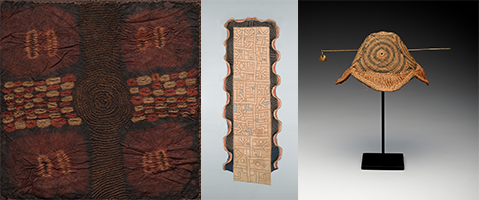--Focus Installation on African Art Details
Garments and Textiles Made From the Woven Fiber--

Dallas, TX—August 2, 2019—The Dallas Museum of Art (DMA) presents Wearable Raffia from Africa, a new exhibition that celebrates African textile design, drawing from the DMA’s extensive collection of African art, one of the leading of its kind in the United States. Opening on August 31, 2019, the exhibition brings together raffia garments from West and Central Africa and the island of Madagascar to reveal the ingenuity of designers across the continent. Organized by Dr. Roslyn A. Walker, the DMA’s Senior Curator of the Arts of Africa, the Americas, and the Pacific and The Margaret McDermott Curator of African Art, the exhibition is on view until next summer and can be seen for free in the Museum’s third floor Textile Gallery.
“The DMA has one of the most significant collections of African Art in the nation, and it is an incredible resource from which to develop exhibitions and programs that offer new perspectives and insights to our audiences,” said Dr. Agustín Arteaga, the DMA’s Eugene McDermott Director. “Often we think of objects inside a vitrine as precious, which they are, but these pieces were once used by people like us. The objects in this exhibition tell their story, and when we share it, they come alive.”
In Africa, before the introduction of imported cotton fabric, tree bark and leaves were the traditional sources of fibers used to make cloth. Raffia, the material harvested from raffia palm leaves, was once one of the most common textile fibers on the continent. Exploring the ingenious use of this vital material, Wearable Raffia from Africa highlights 15 works of art from several groups across four African countries, including the Bamileke (Cameroon), Dida (Côte d’Ivoire), Kuba, Suku, and Teke (Democratic Republic of the Congo), and the Merina (Madagascar).
“Raffia clothing, shoes, and accessories are currently in vogue in the USA and Europe. Since the early 2000s, such Western fashion houses as The House of Dior, Paris, have commissioned raffia fabrics from weavers in Madagascar. In Africa, weavers have been transforming raw raffia into clothing and headwear for centuries,” said Dr. Walker. “This visually appealing exhibition, which includes a ‘please touch’ section, reveals the meticulous craftsmanship, imaginative designs, and ways to wear raffia cloth in Africa.”
Encompassing skirts, a shawl, and headwear, the raffia textiles in this exhibition demonstrate two primary weaving techniques. The Teke, Kuba, and Merina created textiles using looms, while the Dida interlaced raffia threads by hand.
The exhibition, as well as many of its accompanying public programs, features touchable displays that offer another avenue for visitors to learn about raffia weaving. Confirmed events, with more to come, can be found at DMA.org. They currently include:
- Thursday, August 29, 5:30–8:30 p.m., FREE
Make & Take: Wearable Raffia
Join us for a guided art-making series for adults. Make small accessories from raffia to see the versatile nature of this material. Use wrapping and folding techniques to make flowers and tassels to affix on a bag or just as decoration. No previous experience necessary and all materials are provided.
- Wednesday, Date TBD, 12:15 p.m., FREE
Gallery Talk: Wearable Raffia
Artist Lesli Robertson will speak about a new installation of raffia garments and textiles drawn from the DMA’s collection.
Dr. Walker is also the author of The Arts of Africa at the Dallas Museum of Art, a catalogue dedicated to exploring the Museum’s collection of nearly 2,000 objects that represent fifty-two cultures, from Morocco to South Africa.
Images: Dida peoples, prestige panel, first half of 20th century, raffia, Dallas Museum of Art, The Eugene and Margaret McDermott Art Fund, Inc., 2005.5.McD; Kuba peoples, Bushoong group, overskirt with wavy edge (ntshakakot), early 20th century, raffia, cotton, wool, and vegetal fiber, Dallas Museum of Art, Textile Purchase Fund, 2005.41; Kuba peoples, man's hat (laket), 20th century, raffia and brass, collection of Michael and Shelly Dee
About the Dallas Museum of Art
Established in 1903, the Dallas Museum of Art (DMA) is among the 10 largest art museums in the country and is distinguished by its commitment to research, innovation, and public engagement. At the heart of the Museum and its programs is its global collection, which encompasses more than 24,000 works and spans 5,000 years of history, representing a full range of world cultures. Located in the nation’s largest arts district, the Museum acts as a catalyst for community creativity, engaging people of all ages and backgrounds with a diverse spectrum of programming, from exhibitions and lectures to concerts, literary events, and dramatic and dance presentations. Since the Museum’s return to free general admission in 2013, the DMA has welcomed more than 4 million visitors, including more than 800,000 in 2018. For more information, visit DMA.org.
The Dallas Museum of Art is supported, in part, by the generosity of DMA Members and donors, the citizens of Dallas through the City of Dallas Office of Cultural Affairs, and the Texas Commission on the Arts.
###